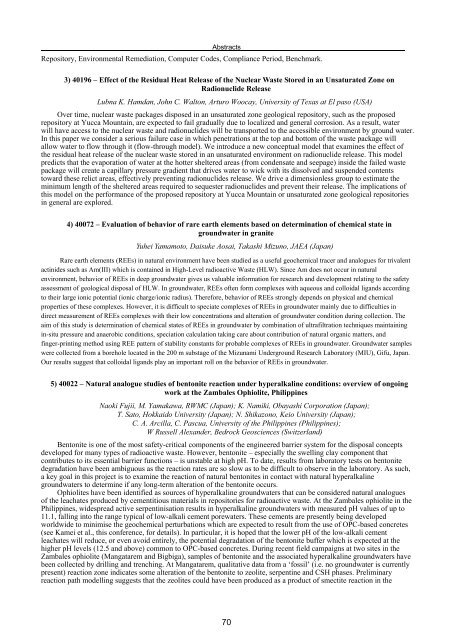The 13th International Conference on Environmental ... - Events
The 13th International Conference on Environmental ... - Events
The 13th International Conference on Environmental ... - Events
Create successful ePaper yourself
Turn your PDF publications into a flip-book with our unique Google optimized e-Paper software.
Abstracts<br />
Repository, Envir<strong>on</strong>mental Remediati<strong>on</strong>, Computer Codes, Compliance Period, Benchmark.<br />
3) 40196 – Effect of the Residual Heat Release of the Nuclear Waste Stored in an Unsaturated Z<strong>on</strong>e <strong>on</strong><br />
Radi<strong>on</strong>uclide Release<br />
Lubna K. Hamdan, John C. Walt<strong>on</strong>, Arturo Woocay, University of Texas at El paso (USA)<br />
Over time, nuclear waste packages disposed in an unsaturated z<strong>on</strong>e geological repository, such as the proposed<br />
repository at Yucca Mountain, are expected to fail gradually due to localized and general corrosi<strong>on</strong>. As a result, water<br />
will have access to the nuclear waste and radi<strong>on</strong>uclides will be transported to the accessible envir<strong>on</strong>ment by ground water.<br />
In this paper we c<strong>on</strong>sider a serious failure case in which penetrati<strong>on</strong>s at the top and bottom of the waste package will<br />
allow water to flow through it (flow-through model). We introduce a new c<strong>on</strong>ceptual model that examines the effect of<br />
the residual heat release of the nuclear waste stored in an unsaturated envir<strong>on</strong>ment <strong>on</strong> radi<strong>on</strong>uclide release. This model<br />
predicts that the evaporati<strong>on</strong> of water at the hotter sheltered areas (from c<strong>on</strong>densate and seepage) inside the failed waste<br />
package will create a capillary pressure gradient that drives water to wick with its dissolved and suspended c<strong>on</strong>tents<br />
toward these relict areas, effectively preventing radi<strong>on</strong>uclides release. We drive a dimensi<strong>on</strong>less group to estimate the<br />
minimum length of the sheltered areas required to sequester radi<strong>on</strong>uclides and prevent their release. <str<strong>on</strong>g>The</str<strong>on</strong>g> implicati<strong>on</strong>s of<br />
this model <strong>on</strong> the performance of the proposed repository at Yucca Mountain or unsaturated z<strong>on</strong>e geological repositories<br />
in general are explored.<br />
4) 40072 – Evaluati<strong>on</strong> of behavior of rare earth elements based <strong>on</strong> determinati<strong>on</strong> of chemical state in<br />
groundwater in granite<br />
Yuhei Yamamoto, Daisuke Aosai, Takashi Mizuno, JAEA (Japan)<br />
Rare earth elements (REEs) in natural envir<strong>on</strong>ment have been studied as a useful geochemical tracer and analogues for trivalent<br />
actinides such as Am(III) which is c<strong>on</strong>tained in High-Level radioactive Waste (HLW). Since Am does not occur in natural<br />
envir<strong>on</strong>ment, behavior of REEs in deep groundwater gives us valuable informati<strong>on</strong> for research and development relating to the safety<br />
assessment of geological disposal of HLW. In groundwater, REEs often form complexes with aqueous and colloidal ligands according<br />
to their large i<strong>on</strong>ic potential (i<strong>on</strong>ic charge/i<strong>on</strong>ic radius). <str<strong>on</strong>g>The</str<strong>on</strong>g>refore, behavior of REEs str<strong>on</strong>gly depends <strong>on</strong> physical and chemical<br />
properties of these complexes. However, it is difficult to speciate complexes of REEs in groundwater mainly due to difficulties in<br />
direct measurement of REEs complexes with their low c<strong>on</strong>centrati<strong>on</strong>s and alterati<strong>on</strong> of groundwater c<strong>on</strong>diti<strong>on</strong> during collecti<strong>on</strong>. <str<strong>on</strong>g>The</str<strong>on</strong>g><br />
aim of this study is determinati<strong>on</strong> of chemical states of REEs in groundwater by combinati<strong>on</strong> of ultrafiltrati<strong>on</strong> techniques maintaining<br />
in-situ pressure and anaerobic c<strong>on</strong>diti<strong>on</strong>s, speciati<strong>on</strong> calculati<strong>on</strong> taking care about c<strong>on</strong>tributi<strong>on</strong> of natural organic matters, and<br />
finger-printing method using REE pattern of stability c<strong>on</strong>stants for probable complexes of REEs in groundwater. Groundwater samples<br />
were collected from a borehole located in the 200 m substage of the Mizunami Underground Research Laboratory (MIU), Gifu, Japan.<br />
Our results suggest that colloidal ligands play an important roll <strong>on</strong> the behavior of REEs in groundwater.<br />
5) 40022 – Natural analogue studies of bent<strong>on</strong>ite reacti<strong>on</strong> under hyperalkaline c<strong>on</strong>diti<strong>on</strong>s: overview of <strong>on</strong>going<br />
work at the Zambales Ophiolite, Philippines<br />
Naoki Fujii, M. Yamakawa, RWMC (Japan); K. Namiki, Obayashi Corporati<strong>on</strong> (Japan);<br />
T. Sato, Hokkaido University (Japan); N. Shikaz<strong>on</strong>o, Keio University (Japan);<br />
C. A. Arcilla, C. Pascua, University of the Philippines (Philippines);<br />
W Russell Alexander, Bedrock Geosciences (Switzerland)<br />
Bent<strong>on</strong>ite is <strong>on</strong>e of the most safety-critical comp<strong>on</strong>ents of the engineered barrier system for the disposal c<strong>on</strong>cepts<br />
developed for many types of radioactive waste. However, bent<strong>on</strong>ite – especially the swelling clay comp<strong>on</strong>ent that<br />
c<strong>on</strong>tributes to its essential barrier functi<strong>on</strong>s – is unstable at high pH. To date, results from laboratory tests <strong>on</strong> bent<strong>on</strong>ite<br />
degradati<strong>on</strong> have been ambiguous as the reacti<strong>on</strong> rates are so slow as to be difficult to observe in the laboratory. As such,<br />
a key goal in this project is to examine the reacti<strong>on</strong> of natural bent<strong>on</strong>ites in c<strong>on</strong>tact with natural hyperalkaline<br />
groundwaters to determine if any l<strong>on</strong>g-term alterati<strong>on</strong> of the bent<strong>on</strong>ite occurs.<br />
Ophiolites have been identified as sources of hyperalkaline groundwaters that can be c<strong>on</strong>sidered natural analogues<br />
of the leachates produced by cementitious materials in repositories for radioactive waste. At the Zambales ophiolite in the<br />
Philippines, widespread active serpentinisati<strong>on</strong> results in hyperalkaline groundwaters with measured pH values of up to<br />
11.1, falling into the range typical of low-alkali cement porewaters. <str<strong>on</strong>g>The</str<strong>on</strong>g>se cements are presently being developed<br />
worldwide to minimise the geochemical perturbati<strong>on</strong>s which are expected to result from the use of OPC-based c<strong>on</strong>cretes<br />
(see Kamei et al., this c<strong>on</strong>ference, for details). In particular, it is hoped that the lower pH of the low-alkali cement<br />
leachates will reduce, or even avoid entirely, the potential degradati<strong>on</strong> of the bent<strong>on</strong>ite buffer which is expected at the<br />
higher pH levels (12.5 and above) comm<strong>on</strong> to OPC-based c<strong>on</strong>cretes. During recent field campaigns at two sites in the<br />
Zambales ophiolite (Mangatarem and Bigbiga), samples of bent<strong>on</strong>ite and the associated hyperalkaline groundwaters have<br />
been collected by drilling and trenching. At Mangatarem, qualitative data from a ‘fossil’ (i.e. no groundwater is currently<br />
present) reacti<strong>on</strong> z<strong>on</strong>e indicates some alterati<strong>on</strong> of the bent<strong>on</strong>ite to zeolite, serpentine and CSH phases. Preliminary<br />
reacti<strong>on</strong> path modelling suggests that the zeolites could have been produced as a product of smectite reacti<strong>on</strong> in the<br />
70
















